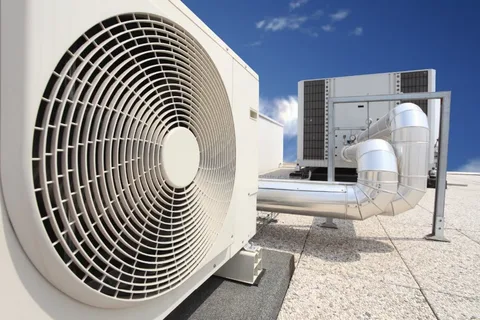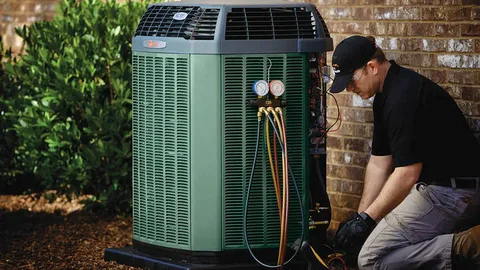Heating & ventilation units create a comfortable and healthy indoor environment. In this blog post, we will delve into the basics of Heating and Ventilation Unit, exploring different aspects such as the types of units available, the importance of ventilation systems, and the role of exhaust ventilation setups in maintaining air quality.
Understanding Heating & Ventilation Basics
Heating & ventilation basics involve controlling indoor temperature and air quality. Heating systems, such as furnaces or heat pumps, warm indoor air. Ventilation systems, like fans or ductwork, circulate air and remove pollutants. Proper ventilation regulates humidity and prevents stale air buildup. Understanding these basics ensures comfortable indoor environments and promotes better health and energy efficiency.
 Choosing the Right Heating and Ventilation Companies
Choosing the Right Heating and Ventilation Companies
Choosing the proper heating & Ventilation Company is crucial for ensuring quality installation, maintenance, and service of your HVAC (heating, ventilation, and air conditioning) systems. Here are factors to consider:
- Experience and Expertise: Look for a company with extensive knowledge and expertise in the HVAC industry. Check their track record, certifications, and customer reviews to gauge their reliability and professionalism.
- Range of Services: Choose a company that offers a comprehensive range of services, including installation, maintenance, repairs, and upgrades for heating & ventilation systems.
- Licensed and Insured: Ensure the company is appropriately licensed and insured for HVAC work in your area. This protects you from liability and ensures compliance with local regulations.
- Quality Products: Consider companies that offer high-quality heating & ventilation products from reputable brands. Quality products are essential for reliable performance and energy efficiency.
- Customer Service: Read reviews and testimonials to evaluate a company’s customer service reputation. Choose a company known for excellent customer service and responsiveness to client needs.
- Cost and Value: While cost is significant, prioritise value over price alone. Look for a company that offers competitive pricing without compromising quality or service.
- Warranty and Guarantees: Inquire about the company’s warranties and guarantees for its products and services. A solid warranty provides peace of mind and protection for your investment.
- References and Recommendations: Seek recommendations from friends, family, or neighbours who have used the services of heating & ventilation companies. Personal referrals can provide valuable insights into the company’s reliability and performance.
By considering these factors and conducting thorough research, you can select Heating and Ventilation Companies that meet your needs and ensures optimal performance and comfort for your home or business.
Exploring Types of Heating & Ventilation Unit
The marketplace offers an array of heating & ventilation units, each designed to cater to specific environmental and spatial needs. Central heating systems are widely utilised for their ability to evenly distribute heat throughout large spaces via a network of ducts and vents. For areas where ductwork is impractical or too costly to install, ductless mini-split systems provide an efficient and versatile alternative, offering heating and cooling solutions without requiring extensive modifications.
Additionally, radiant heating systems, which deliver heat directly from hot surfaces to the people and objects in the room via infrared radiation, are gaining popularity for their comfort levels and efficiency, particularly in spaces where traditional heating methods are ineffective or undesirable. When selecting a Heating & Ventilation Unit, considering the specific characteristics of the space, including size, layout, insulation, energy efficiency ratings, and overall cost, is imperative to ensure optimal performance and comfort.
The Role of Ventilation in Heating Systems
Ventilation is a critical aspect of heating systems, integral to promoting a harmonious air flow within indoor environments. Its primary function is to facilitate the exchange of indoor air with fresh outdoor air, ensuring that air quality does not deteriorate due to pollutants or excess moisture. This continuous exchange is vital for diluting and removing airborne contaminants, including allergens, dust, and chemical vapours, which can accumulate to harmful levels in poorly ventilated spaces.
Moreover, efficient ventilation supports heating systems by regulating indoor temperatures and preventing the formation of dampness and mould, which are common in areas with stagnant air; by ensuring a steady supply of fresh air, ventilation aids in creating a healthier, more comfortable living and working environment, particularly during the colder months when buildings are sealed more tightly.
The interplay between heating and efficient ventilation mechanisms is thus essential, as it not only enhances thermal comfort but also safeguards the health of occupants by maintaining superior air quality.
Critical Considerations for Ventilation System Installation
When installing a ventilation system, several key considerations should be taken into account to ensure optimal performance and effectiveness:
Building Layout
Assess the building’s layout and size to determine the most suitable placement for ventilation equipment, ductwork, and air vents.
Airflow Requirements
Calculate the required airflow rate based on the space’s size, occupancy levels, and ventilation standards or regulations.
Ventilation Strategy
Choose an appropriate ventilation strategy, such as natural ventilation, mechanical ventilation, or a combination of both, depending on the building’s requirements and environmental conditions.
Equipment Selection
Select ventilation equipment, such as fans, air handlers, and ductwork, that is appropriately sized and designed to meet the building’s ventilation needs efficiently.
Control Systems
Implement control systems, sensors, and automation features to regulate airflow, adjust ventilation rates, and optimise energy efficiency based on occupancy and indoor air quality.
Compliance
Ensure compliance with building codes, ventilation standards, and indoor air quality regulations to maintain occupants’ healthy and safe environment.
By carefully considering these factors during ventilation system installation, you can design and implement an effective ventilation solution that meets the needs of the building and its occupants while promoting comfort and indoor air quality.
Benefits of Professional Ventilation Installation
Professional installation of ventilation systems offers several benefits:
Expertise and Experience
HVAC professionals have the knowledge and experience to assess ventilation needs properly, select the right equipment, and install systems efficiently.
Proper Sizing and Placement
Professionals ensure that ventilation equipment is correctly sized and strategically placed to provide optimal airflow and ventilation throughout the space.
Compliance
HVAC professionals are familiar with building codes and regulations related to ventilation, ensuring that installations meet safety and compliance standards.
Quality Workmanship
Professional installers use industry best practices and high-quality materials to ensure reliable performance and longevity of ventilation systems.
Warranty Coverage
Many HVAC companies offer warranties on Ventilation Installation work, providing peace of mind and protection against defects or issues that may arise after installation.
Safety
Professional installation minimises the risk of installation errors or safety hazards, ensuring a safe and secure ventilation system for building occupants.
Overall, investing in professional ventilation system installation ensures efficient operation, compliance with regulations, and long-term reliability, ultimately promoting better indoor air quality and comfort.
The Importance of an Exhaust Ventilation System
An exhaust ventilation system is crucial in maintaining indoor air quality and promoting occupant health and comfort. By removing pollutants, moisture, odours, and stale air from enclosed spaces, such as kitchens, bathrooms, and industrial facilities, exhaust ventilation setups help prevent the buildup of harmful contaminants and maintain a fresh and breathable indoor environment.
Additionally, exhaust systems can help control humidity levels, prevent mould and mildew growth, and reduce the risk of respiratory problems and other health issues associated with poor indoor air quality. Exhaust ventilation setups ensure a safe, healthy, and comfortable indoor environment.
How to Choose the Right Exhaust Ventilation Setup?
When selecting the right exhaust ventilation setup, consider several vital factors to ensure optimal performance and efficiency. Begin by assessing the space’s specific requirements, including the size, layout, and purpose of the area requiring ventilation. Determine the type and volume of pollutants or contaminants that need removal, such as cooking fumes, moisture, odours, or airborne particles. Next, evaluate the available ventilation options, including wall-mounted fans, ceiling-mounted fans, ducted systems, or combination units. Consider each option’s airflow capacity, noise level, energy efficiency, and ease of installation and maintenance.
Ensure the chosen ventilation system complies with relevant building codes, regulations, and industry standards. Finally, consult with HVAC professionals or ventilation experts to receive personalised recommendations and guidance based on your specific requirements and budget constraints. By carefully considering these factors, you can choose the right exhaust ventilation setup to remove pollutants and maintain a healthy indoor environment.
Maintenance Tips for Heating & Ventilation Unit
Regular maintenance is essential to maintain the optimal performance of Heating & Ventilation Unit. Start by replacing air filters every 1-3 months to ensure proper airflow and minimise strain on the system. Clean air vents and ducts periodically to remove dust, debris, and potential blockages. Inspect heating elements, fans, and motors for signs of wear or damage, and lubricate moving parts as needed. Schedule professional HVAC maintenance annually to address any issues, perform thorough cleaning, and optimise system efficiency. Additionally, monitor thermostat settings and energy usage to identify abnormalities and ensure efficient operation of the heating & ventilation units.
Common Issues with Heating and Ventilation Systems
Common issues with heating & ventilation systems include inadequate airflow, malfunctioning thermostats, dirty or clogged filters, and faulty electrical components. These issues can result in uneven heating, poor air quality, and increased energy consumption. Additionally, leaks in ductwork, worn-out fan belts, and refrigerant leaks in air conditioning units can decrease efficiency and performance. Regular maintenance and timely repairs are crucial for addressing these issues and ensuring the proper functioning of heating and ventilation systems. Professional inspections can help identify and resolve potential problems before they escalate, minimising downtime and costly repairs.
The Future of Heating & Ventilation Technology
The future of heating & ventilation technology is poised for innovation and advancement. Emerging trends include integrating intelligent controls and automation, enabling more precise temperature and airflow management for enhanced comfort and energy efficiency. Additionally, there is a growing emphasis on sustainability, with the development of eco-friendly heating & ventilation solutions that utilise renewable energy sources and minimise environmental impact. Materials, design, and energy storage advancements are also expected to drive the evolution of heating & ventilation systems towards greater efficiency and sustainability.
Conclusion & Final Thoughts
In conclusion, heating & ventilation systems are vital for maintaining comfort, health, and energy efficiency in indoor environments. By staying informed about the latest technology and trends, prioritising regular maintenance, and seeking professional assistance, individuals and businesses can ensure optimal performance and longevity of Heating and Ventilation Unit. Investing in high-quality equipment and sustainable practices contributes to a healthier and more sustainable future.
FAQ’s
How often should I replace the air filters in my heating & ventilation system?
Answer: Air filters should typically be replaced every 1-3 months to ensure optimal airflow and indoor air quality.
What is the ideal temperature setting for my thermostat during winter?
Answer: The ideal temperature setting is generally between 68 and 72 degrees Fahrenheit for comfort and energy efficiency.
How can I improve ventilation in my home without compromising energy efficiency?
Answer: Installing energy recovery ventilators (ERVs) or heat recovery ventilators (HRVs) can improve ventilation while recovering heat or coolness from outgoing air.
What are common signs that my heating system needs professional maintenance?
Answer: Common signs include uneven heating, unusual noises, increased energy bills, and frequent cycling on and off.
How can I make my heating and ventilation system more energy-efficient?
Answer: Regular maintenance, sealing air leaks, upgrading to energy-efficient equipment, and using programmable thermostats for Heating and Ventilation systems are effective ways to improve energy efficiency.
| Other Good Articles to Read |
| Niche Blogs Connect |
| Blogs 97 |
| Blog Stitution |
| Blogs Unplugged |
| Blogs Cotch Rouge |
| Blog Signatr |
| Blog Sintonias |
| Blog Zilla |
| Consumer Forums |
| Finance Forums |
| G Blogs |
| Too Blog |
| Related Business Listings |
| Contact Directory |
| Local Business Profiles |



